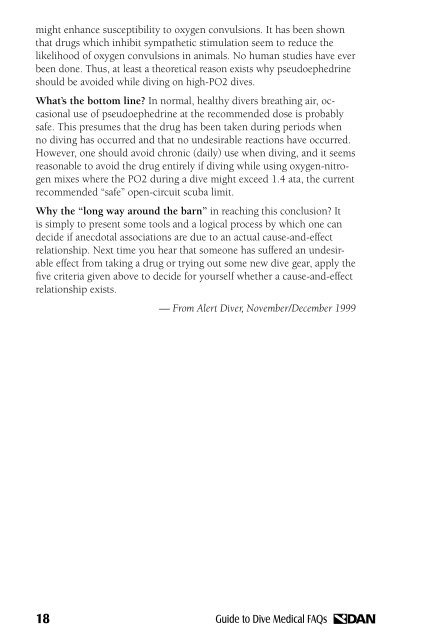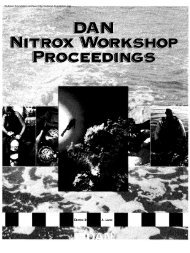- Page 1 and 2: By Divers Alert Network
- Page 3 and 4: TABLE OF CONTENTS SECTiON 1 — GEN
- Page 5 and 6: SECTiON 11 — NErvOuS SySTEM 141 C
- Page 7 and 8: Guide to Dive Medical FAQs 7
- Page 9 and 10: How can mask squeeze cause these sy
- Page 11 and 12: The Scuba Blues DAN examines the po
- Page 13 and 14: hand and Foot Edema After A Dive By
- Page 15 and 16: 1. A cave diver breathing a PO2 [ox
- Page 17: While we have some evidence of an a
- Page 21 and 22: Tank Care Tips Seawater combined wi
- Page 23 and 24: Divers with discomfort may indeed b
- Page 25 and 26: Pain occurring in one or more locat
- Page 27 and 28: DAN members also receive a Member B
- Page 29 and 30: Basic instincts DAN Explores A Hypo
- Page 31 and 32: Dealing With Complications The cent
- Page 33 and 34: Check weight and inflator. Locate a
- Page 35 and 36: Guide to Dive Medical FAQs 35
- Page 37 and 38: Hypertension Description of Conditi
- Page 39 and 40: Medication Used in Treatment: Medic
- Page 41 and 42: Mitral Valve Prolapse Description o
- Page 43 and 44: and hyperdynamic metabolism; these
- Page 45 and 46: The pain may be significant enough
- Page 47 and 48: pacemakers and Diving DAN Offers So
- Page 49 and 50: vasovagal and Carotid Sinus Syncope
- Page 51 and 52: Guide to Dive Medical FAQs 51
- Page 53 and 54: Although United States Navy “retu
- Page 55 and 56: The industry Examines Flying After
- Page 57 and 58: Low Living, high Diving DAN discuss
- Page 59 and 60: Guide to Dive Medical FAQs 59
- Page 61 and 62: teeth — the incisors and the cani
- Page 63 and 64: Still, the most common cause of wha
- Page 65 and 66: Diving without dentures can be diff
- Page 67 and 68: oot Canal Can this procedure affect
- Page 69 and 70:
Finally, some types of pain medicin
- Page 71 and 72:
Before the pressure Gets Too Great,
- Page 73 and 74:
Middle ear surgery is more complica
- Page 75 and 76:
Difficulty Equalizing It takes me a
- Page 77 and 78:
7. If your doctor agrees, decongest
- Page 79 and 80:
Over-the-counter medication used fo
- Page 81 and 82:
could wedge the plug in the ear can
- Page 83 and 84:
Nausea and vomiting are also common
- Page 85 and 86:
Exercise Training and Scuba Diving
- Page 87 and 88:
In the 1990s, an altitude study by
- Page 89 and 90:
muscles and supporting structures f
- Page 91 and 92:
Medication Used: Non-steroid medica
- Page 93 and 94:
significant back pain and spasm. Th
- Page 95 and 96:
Condition: Disc Surgery Description
- Page 97 and 98:
impaired platelet function may caus
- Page 99 and 100:
The second question considers an in
- Page 101 and 102:
Gastrointestinal issues Consider Th
- Page 103 and 104:
ChrONiC CONDiTiONS These conditions
- Page 105 and 106:
Hiatal Hernia Condition: In a hiata
- Page 107 and 108:
Esophageal Diverticulae Condition:
- Page 109 and 110:
Guide to Dive Medical FAQs 109
- Page 111 and 112:
Guide to Dive Medical FAQs 111
- Page 113 and 114:
Coral poisoning occurs if coral abr
- Page 115 and 116:
If the injured person appears intox
- Page 117 and 118:
a more potent topical steroid. Topi
- Page 119 and 120:
you are able to apply the pressure-
- Page 121 and 122:
During recovery from ciguatera pois
- Page 123 and 124:
What’s Next? These measures, thou
- Page 125 and 126:
feels hot to touch and hot feels co
- Page 127 and 128:
Guide to Dive Medical FAQs 127
- Page 129 and 130:
Diving & The Body Systems Diving wi
- Page 131 and 132:
Body System: Endocrine THYROID Cond
- Page 133 and 134:
Body System: Blood SICKLE CELL ANEM
- Page 135 and 136:
Additional Information: Leukemia So
- Page 137 and 138:
Body System: Generalized LUPUS By D
- Page 139 and 140:
Antimalarials such as hydroxychloro
- Page 141 and 142:
Guide to Dive Medical FAQs 141
- Page 143 and 144:
Whether you have experienced one of
- Page 145 and 146:
Fitness & Diving: 1. Most strokes o
- Page 147 and 148:
and sedatives to alter behavior, pa
- Page 149 and 150:
2. Persons with MS are advised not
- Page 151 and 152:
high-pressure Ophthalmology DAN Ans
- Page 153 and 154:
Timolol, for example, may result in
- Page 155 and 156:
In general, it’s best to wait unt
- Page 157 and 158:
I make 30-40 divers each year. I wa
- Page 159 and 160:
Guide to Dive Medical FAQs 159
- Page 161 and 162:
Finally, divers have different chem
- Page 163 and 164:
on the dive excursion who may be at
- Page 165 and 166:
Lamotrigine / Lamictal Lamotrigine
- Page 167 and 168:
Possible side effects that may be a
- Page 169 and 170:
Valproic Acid / Depakote Valproic a
- Page 171 and 172:
National Alliance for the Mentally
- Page 173 and 174:
An overreactive anxiety state usual
- Page 175 and 176:
Some diving activities inevitably l
- Page 177 and 178:
Ed. Note: Regarding divers’ use o
- Page 179 and 180:
Some individuals, no matter how muc
- Page 181 and 182:
psychological issues in Diving —
- Page 183 and 184:
Negative Symptoms These affect inte
- Page 185 and 186:
Possible adverse side effects for d
- Page 187 and 188:
• Olanzapine may cause muscle sti
- Page 189 and 190:
Naltrexone / Revia Naltrexone is us
- Page 191 and 192:
Guide to Dive Medical FAQs 191
- Page 193 and 194:
The human body consumes oxygen to g
- Page 195 and 196:
Other conditions that have an incre
- Page 197 and 198:
The diver, a 37-year-old man, also
- Page 199 and 200:
Incident One — Carbon Dioxide Ret
- Page 201 and 202:
Fatalities, Injuries and Safe Dives
- Page 203 and 204:
Impaired Consciousness and Interact
- Page 205 and 206:
FIGURE 4: The variation in individu
- Page 207 and 208:
Your discomfort might be due to mil
- Page 209 and 210:
DAN Explores Fitness and Diving iss
- Page 211 and 212:
Ovarian Tumor The Condition: Ovaria
- Page 213 and 214:
Fitness and Diving Issues: Is it sa
- Page 215 and 216:
Menstruation During Diving Activiti
- Page 217 and 218:
Guide to Dive Medical FAQs 217
- Page 219 and 220:
symptoms. Commercial airline flight
- Page 221 and 222:
torso. Another disorder, characteri
- Page 223 and 224:
Editor’s note: The DAN Emergency
- Page 225 and 226:
where he provided 100 percent oxyge
- Page 227 and 228:
Case 6 Neurological DCI With Comple
- Page 229 and 230:
index Abdominal Surgery 104 ACE Inh
- Page 231 and 232:
Hypoxia 30, 133 Hysterectomy 213, 2

















